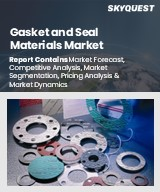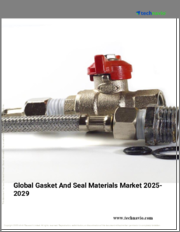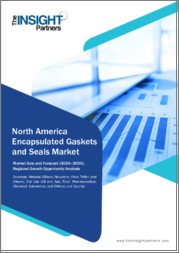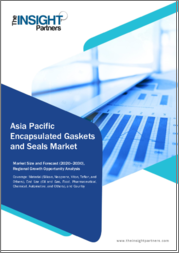
|
시장보고서
상품코드
1642836
개스킷 및 씰 시장 규모, 점유율, 동향, 예측 : 제품, 재료, 용도, 최종 용도, 지역별(2025-2033년)Gaskets and Seals Market Size, Share, Trends and Forecast by Product, Material, Application, End-Use, and Region, 2025-2033 |
||||||
개스킷 및 씰 세계 시장 규모는 2024년 677억 달러에 달했습니다. IMARC Group은 향후 2033년에는 910억 달러에 이르고, 2025-2033년의 CAGR은 3.3%가 될 것으로 예측했습니다. 현재 아시아태평양은 시장을 독점하고 있습니다. 이 시장은 자동차, 항공우주, 석유 및 가스 등 주요 산업에서의 수요 증가, 다양한 분야에 걸친 엄격한 규제 기준, 재료 과학의 지속적인 기술 발달에 견인되어 꾸준한 성장을 이루고 있습니다.
개스킷 및 씰 시장 동향 :
산업화 및 기계 수요 증가
세계 시장의 주요 원동력이 되는 것은 다양한 분야에서 산업화 수준의 상승입니다. 이 성장은 특히 신흥 경제 국가에서 현저하며, 급속한 산업 발전이 기계 설비 수요 증가로 이어지고 있습니다. 또한 다양한 산업기계에서 다양한 압력과 온도에서 누출을 방지하고 시스템의 무결성을 유지하는 데 필수적인 부품이 되었습니다. 자동차, 항공우주, 일렉트로닉스, 석유 및 가스 등 작업 효율과 안전성을 위해 이러한 부품에 크게 의존하는 산업의 확대가 시장의 성장을 더욱 자극하고 있습니다. 게다가 보다 내구성이 높고 효율적인 실링 솔루션을 요구하는 산업기계의 기술 혁신과 발달이 계속되고 있는 것도 시장의 정세 변화에 기여하고 있습니다.
재료과학의 기술 발전
시장 성장을 뒷받침하는 중요한 요소는 재료 과학의 지속적인 발전입니다. 이에 따라 발포 폴리테트라플루오로에틸렌(ePTFE)이나 신규 실리콘 컴파운드 등 신소재의 개발이 진행되어 보다 효과적이고 오래 지속되는 실링 솔루션의 생산으로 이어지고 있습니다. 이러한 재료는 내화학성, 열 안정성, 내구성 등의 특성이 향상되어 가혹한 환경에서 광범위한 용도에 적합합니다. 특히 자동차 산업은 성능과 안전성을 손상시키지 않으면서 보다 가볍고 저연비의 자동차를 제조할 수 있기 때문에 이러한 혁신의 혜택을 누리고 있습니다. 게다가 지속가능성과 환경규제에 대한 관심 증가는 제조업체에게 친환경적 적합성 재료의 개발을 촉구하고 시장에 긍정적인 영향을 미칩니다.
엄격한 규제 기준 및 안전 요구 사항
세계 시장은 다양한 산업 및 정부가 부과하는 엄격한 규제 기준 및 안전 요구 사항에도 영향을 받고 있습니다. 이러한 규제는 특히 항공우주산업, 자동차산업, 석유 및 가스산업 등 씰의 결함이 심각한 사태를 초래할 수 있는 중요한 용도에 있어서 그 신뢰성과 품질을 보증하는 것입니다. 예를 들어, 항공우주 산업에서는 극단적 인 조건을 견딜 수 있도록 매우 특수하고 품질이 보장되는 밀봉 솔루션이 필요합니다. 마찬가지로 자동차 산업에서는 배출 가스 및 연비에 대한 규제가 고성능 밀봉 솔루션의 필요성을 높이고 있습니다. 이러한 규제의 압력은 제조업체에 R&D 투자와 첨단 제조 기술의 채택을 강요하는 것으로, 혁신을 촉진하고 성능과 품질의 지속적인 향상을 보장합니다.
목차
제1장 서문
제2장 조사 범위와 조사 방법
- 조사의 목적
- 이해관계자
- 데이터 소스
- 1차 정보
- 2차 정보
- 시장 추정
- 상향식 접근
- 하향식 접근
- 조사 방법
제3장 주요 요약
제4장 소개
- 개요
- 주요 업계 동향
제5장 세계의 개스킷 및 씰 시장
- 시장 개요
- 시장 실적
- COVID-19의 영향
- 시장 분석 : 제품별
- 시장 분석 : 재료별
- 시장 분석 : 용도별
- 시장 내역 : 최종 용도별
- 시장 분석 : 지역별
- 시장 예측
제6장 시장 분석 : 제품별
- 개스킷
- 시장 동향
- 시장 분석 : 유형별
- 금속 개스킷
- 고무 개스킷
- 코르크 개스킷
- 비석면 개스킷
- 나선형 개스킷
- 기타
- 시장 예측
- 씰
- 시장 동향
- 시장 분석 : 유형별
- 샤프트 씰
- 성형 씰
- 자동차 바디 씰
- 기타
- 시장 예측
제7장 시장 분석 : 재료별
- 섬유
- 시장 동향
- 시장 예측
- 흑연
- 시장 동향
- 시장 예측
- PTFE
- 시장 동향
- 시장 예측
- 고무
- 시장 동향
- 시장 예측
- 실리콘
- 시장 동향
- 시장 예측
- 기타
- 시장 동향
- 시장 예측
제8장 시장 분석 : 용도별
- 자동차
- 시장 동향
- 시장 예측
- 산업기계
- 시장 동향
- 시장 예측
- 전기 및 전자
- 시장 동향
- 시장 예측
- 해상 및 철도
- 시장 동향
- 시장 예측
- 항공우주
- 시장 동향
- 시장 예측
- 석유 및 가스
- 시장 동향
- 시장 예측
- 화학제품 및 석유화학제품제품
- 시장 동향
- 시장 예측
- 기타
- 시장 동향
- 시장 예측
제9장 시장 내역: 최종 용도별
- 제조업체
- 시장 동향
- 시장 예측
- 애프터마켓
- 시장 동향
- 시장 예측
제10장 시장 분석 : 지역별
- 아시아태평양
- 시장 동향
- 시장 예측
- 유럽
- 시장 동향
- 시장 예측
- 북미
- 시장 동향
- 시장 예측
- 중동 및 아프리카
- 시장 동향
- 시장 예측
- 라틴아메리카
- 시장 동향
- 시장 예측
제11장 SWOT 분석
- 개요
- 강점
- 약점
- 기회
- 위협
제12장 밸류체인 분석
제13장 Porter's Five Forces 분석
- 개요
- 구매자의 협상력
- 공급기업의 협상력
- 경쟁도
- 신규 참가업체의 위협
- 대체품의 위협
제14장 경쟁 구도
- 시장 구조
- 주요 기업
- 주요 기업 프로파일
- AB SKF
- Dana Incorporated
- ElringKlinger
- Flowserve
- Trelleborg
- Freudenberg Sealing Technologies
- Federal-Mogul
- Smiths Group
- BRUSS Sealing Systems
- Cooper Standard Holding
- Garlock Sealing Technologies
- Daetwyler Holding
The global gaskets and seals market size was valued at USD 67.7 Billion in 2024. Looking forward, IMARC Group estimates the market to reach USD 91.0 Billion by 2033, exhibiting a CAGR of 3.3% during 2025-2033. Asia Pacific currently dominates the market. The market is experiencing steady growth driven by the increasing demand from key industries, such as automotive, aerospace, and oil and gas, stringent regulatory standards across various sectors, and continuous technological advancements in material science.
Gaskets and Seals Market Trends:
Increasing industrialization and machinery demand
The global market is primarily driven by the rising level of industrialization across various sectors. This growth is particularly evident in emerging economies, where rapid industrial development is leading to increased demand for machinery and equipment. Additionally, they are essential components in a wide range of industrial machinery, ensuring leak prevention and maintaining system integrity under varying pressures and temperatures. The expansion of industries such as automotive, aerospace, electronics, and oil and gas, which heavily rely on these components for operational efficiency and safety, further stimulates market growth. Moreover, the ongoing innovation and advancements in industrial machinery, demanding more durable and efficient sealing solutions, contribute to the changing landscape of the market.
Technological advancements in material science
A significant factor propelling the growth of the market is the continuous advancement in material science. Along with this, the development of new materials, such as expanded polytetrafluoroethylene (ePTFE) and novel silicone compounds, is leading to the production of more effective and long-lasting sealing solutions. These materials offer enhanced properties including chemical resistance, thermal stability, and durability, making them suitable for a wide range of applications in harsh environments. The automotive industry, in particular, benefits from these technological innovations, as they allow for the manufacture of lighter, more fuel-efficient vehicles without compromising on performance or safety. Furthermore, the increasing focus on sustainability and environmental regulations is encouraging manufacturers to develop eco-friendly and compliant materials, thereby positively influencing the market.
Stringent regulatory standards and safety requirements
The global market is also influenced by the stringent regulatory standards and safety requirements imposed by various industries and governments. These regulations ensure their reliability and quality, particularly in critical applications such as aerospace, automotive, and oil and gas industries where seal failure can lead to severe consequences. For instance, the aerospace industry requires highly specific and quality-assured sealing solutions to withstand extreme conditions. Similarly, in the automotive sector, regulations related to emissions and fuel efficiency drive the need for high-performance sealing solutions. These regulatory pressures compel manufacturers to invest in R&D and adopt advanced manufacturing techniques, thereby fostering innovation and ensuring continuous improvement in performance and quality.
Gaskets and Seals Industry Segmentation:
Breakup by Product:
Gaskets
Metallic Gasket
Rubber Gasket
Cork Gasket
Non-Asbestos Gasket
Spiral Wound Gasket
Others
Seals
Shaft Seals
Molded Seals
Motor Vehicle Body Seals
Others
Seals account for the majority of the market share
Breakup by Material:
Fiber
Graphite
PTFE
Rubber
Silicones
Others
Rubber holds the largest share in the industry
Breakup by Application:
Automotive
Industrial Machinery
Electrical and Electronics
Marine & Rail
Aerospace
Oil & Gas
Chemicals & Petrochemicals
Others
Automotive represents the leading market segment
Breakup by End-Use:
OEM
Aftermarket
OEM represents the leading market segment
Breakup by Region:
Asia Pacific
North America
Europe
Middle East and Africa
Latin America
Asia Pacific leads the market, accounting for the largest gaskets and seals market share
The market research report has also provided a comprehensive analysis of all the major regional markets, which include North America, Asia Pacific, Europe, Middle East and Africa, and Latin America. According to the report, Asia Pacific accounted for the largest market share.
The market research report has provided a comprehensive analysis of the competitive landscape. Detailed profiles of all major companies have also been provided. Some of the key players in the market include:
AB SKF
Dana Incorporated
ElringKlinger
Flowserve
Trelleborg
Freudenberg Sealing Technologies
Federal-Mogul
Smiths Group
BRUSS Sealing Systems
Cooper Standard Holding
Garlock Sealing Technologies
Daetwyler Holding
Key Questions Answered in This Report
- 1. What are gaskets and seals?
- 2. How big is the global gaskets and seals market?
- 3. What is the expected growth rate of the global gaskets and seals market during 2025-2033?
- 4. What are the key factors driving the global gaskets and seals market?
- 5. What is the leading segment of the global gaskets and seals market based on the product?
- 6. What is the leading segment of the global gaskets and seals market based on the material?
- 7. What is the leading segment of the global gaskets and seals market based on the application?
- 8. What is the leading segment of the global gaskets and seals market based on the end-use?
- 9. What are the key regions in the global gaskets and seals market?
- 10. Who are the key players/companies in the global gaskets and seals market?
Table of Contents
1 Preface
2 Scope and Methodology
- 2.1 Objectives of the Study
- 2.2 Stakeholders
- 2.3 Data Sources
- 2.3.1 Primary Sources
- 2.3.2 Secondary Sources
- 2.4 Market Estimation
- 2.4.1 Bottom-Up Approach
- 2.4.2 Top-Down Approach
- 2.5 Forecasting Methodology
3 Executive Summary
4 Introduction
- 4.1 Overview
- 4.2 Key Industry Trends
5 Global Gaskets and Seals Market
- 5.1 Market Overview
- 5.2 Market Performance
- 5.3 Impact of COVID-19
- 5.4 Market Breakup by Product
- 5.5 Market Breakup by Material
- 5.6 Market Breakup by Application
- 5.7 Market Breakup by End-Use
- 5.8 Market Breakup by Region
- 5.9 Market Forecast
6 Market Breakup by Product
- 6.1 Gaskets
- 6.1.1 Market Trends
- 6.1.2 Market Breakup by Type
- 6.1.2.1 Metallic Gasket
- 6.1.2.2 Rubber Gasket
- 6.1.2.3 Cork Gasket
- 6.1.2.4 Non-Asbestos Gasket
- 6.1.2.5 Spiral Wound Gasket
- 6.1.2.6 Others
- 6.1.3 Market Forecast
- 6.2 Seals
- 6.2.1 Market Trends
- 6.2.2 Market Breakup by Type
- 6.2.2.1 Shaft Seals
- 6.2.2.2 Molded Seals
- 6.2.2.3 Motor Vehicle Body Seals
- 6.2.2.4 Others
- 6.2.3 Market Forecast
7 Market Breakup by Material
- 7.1 Fiber
- 7.1.1 Market Trends
- 7.1.2 Market Forecast
- 7.2 Graphite
- 7.2.1 Market Trends
- 7.2.2 Market Forecast
- 7.3 PTFE
- 7.3.1 Market Trends
- 7.3.2 Market Forecast
- 7.4 Rubber
- 7.4.1 Market Trends
- 7.4.2 Market Forecast
- 7.5 Silicones
- 7.5.1 Market Trends
- 7.5.2 Market Forecast
- 7.6 Others
- 7.6.1 Market Trends
- 7.6.2 Market Forecast
8 Market Breakup by Application
- 8.1 Automotive
- 8.1.1 Market Trends
- 8.1.2 Market Forecast
- 8.2 Industrial Machinery
- 8.2.1 Market Trends
- 8.2.2 Market Forecast
- 8.3 Electrical and Electronics
- 8.3.1 Market Trends
- 8.3.2 Market Forecast
- 8.4 Marine & Rail
- 8.4.1 Market Trends
- 8.4.2 Market Forecast
- 8.5 Aerospace
- 8.5.1 Market Trends
- 8.5.2 Market Forecast
- 8.6 Oil & Gas
- 8.6.1 Market Trends
- 8.6.2 Market Forecast
- 8.7 Chemicals & Petrochemicals
- 8.7.1 Market Trends
- 8.7.2 Market Forecast
- 8.8 Others
- 8.8.1 Market Trends
- 8.8.2 Market Forecast
9 Market Breakup by End-Use
- 9.1 OEM
- 9.1.1 Market Trends
- 9.1.2 Market Forecast
- 9.2 Aftermarket
- 9.2.1 Market Trends
- 9.2.2 Market Forecast
10 Market Breakup by Region
- 10.1 Asia Pacific
- 10.1.1 Market Trends
- 10.1.2 Market Forecast
- 10.2 Europe
- 10.2.1 Market Trends
- 10.2.2 Market Forecast
- 10.3 North America
- 10.3.1 Market Trends
- 10.3.2 Market Forecast
- 10.4 Middle East and Africa
- 10.4.1 Market Trends
- 10.4.2 Market Forecast
- 10.5 Latin America
- 10.5.1 Market Trends
- 10.5.2 Market Forecast
11 SWOT Analysis
- 11.1 Overview
- 11.2 Strengths
- 11.3 Weaknesses
- 11.4 Opportunities
- 11.5 Threats
12 Value Chain Analysis
13 Porter's Five Forces Analysis
- 13.1 Overview
- 13.2 Bargaining Power of Buyers
- 13.3 Bargaining Power of Suppliers
- 13.4 Degree of Competition
- 13.5 Threat of New Entrants
- 13.6 Threat of Substitutes
14 Competitive Landscape
- 14.1 Market Structure
- 14.2 Key Players
- 14.3 Profiles of Key Players
- 14.3.1 AB SKF
- 14.3.2 Dana Incorporated
- 14.3.3 ElringKlinger
- 14.3.4 Flowserve
- 14.3.5 Trelleborg
- 14.3.6 Freudenberg Sealing Technologies
- 14.3.7 Federal-Mogul
- 14.3.8 Smiths Group
- 14.3.9 BRUSS Sealing Systems
- 14.3.10 Cooper Standard Holding
- 14.3.11 Garlock Sealing Technologies
- 14.3.12 Daetwyler Holding



















